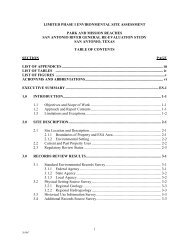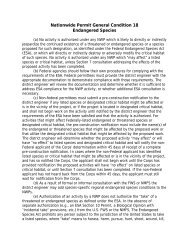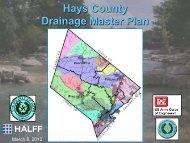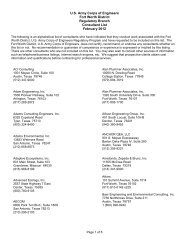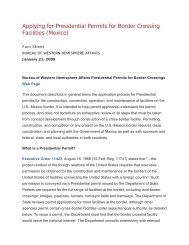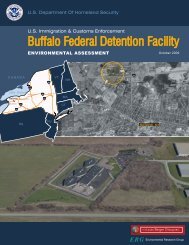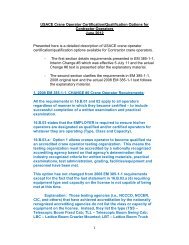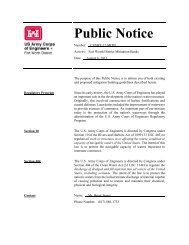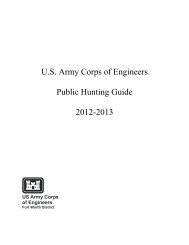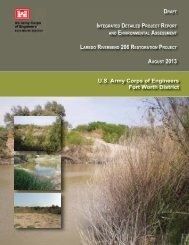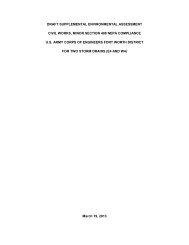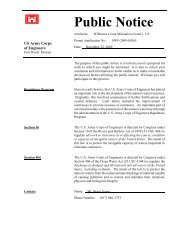environmental assessment us border patrol, tucson sector
environmental assessment us border patrol, tucson sector
environmental assessment us border patrol, tucson sector
You also want an ePaper? Increase the reach of your titles
YUMPU automatically turns print PDFs into web optimized ePapers that Google loves.
3-18123456789101112131415161718192021222324252627282930313233343536373839404142434445463.7 PROTECTED SPECIES AND CRITICAL HABITATS3.7.1 Affected EnvironmentThe Endangered Species Act (ESA) of 1973 (16 USC § 1531 et seq., as amended) defines anendangered species as a species in danger of extinction throughout all or a significant portion ofits range. A threatened species is a species likely to become endangered within the foreseeablefuture throughout all or a significant portion of its range. Proposed species are those that havebeen formally submitted to Congress for official listing as threatened or endangered. Speciesmay be considered endangered or threatened when any of the five following criteria occurs: (1)current/imminent destruction, modification, or curtailment of their habitat or range; (2) over<strong>us</strong>eof the species for commercial, recreational, scientific, or educational purposes; (3) disease orpredation; (4) inadequacy of existing regulatory mechanisms; and (5) other natural or humaninducedfactors affect continued existence. In addition, the USFWS has identified species thatare candidates for listing as a result of identified threats to their continued existence. Thecandidate designation includes those species for which the USFWS has sufficient information tosupport proposals to list as endangered or threatened under the ESA. However, proposed ruleshave not yet been issued beca<strong>us</strong>e such actions are precluded at present by other listing activity.3.7.1.1 Federally Listed SpeciesThe USFWS is the Federal agency responsible for implementing the ESA for terrestrial andaquatic species. The responsibilities of the USFWS under the ESA include: 1) identification ofthreatened and endangered species; 2) identification of Critical Habitats for listed species; 3)implementation of research on, and recovery efforts for, these species; and 4) consultation withother Federal agencies concerning measures to avoid harm to listed species. There are 21Federally listed endangered (E) and threatened (T) species, one proposed E species, oneproposed T species, and six candidate (C) species known to occur in Cochise County, Arizona(USFWS 2010). A list of these species is presented in Table 3-1. Of these 29 species,potentially suitable habitat is located within or adjacent to the alternative project sites for two:the Cochise pinc<strong>us</strong>hion cact<strong>us</strong> (Coryphantha robbinsorum) and the lesser long-nosed bat(Leptonycteris curasoae yerbabuenae) (Table 3-1).Cochise Pinc<strong>us</strong>hion Cact<strong>us</strong>The Cochise pinc<strong>us</strong>hion cact<strong>us</strong> typically grows on gray, rolling, limestone hills at elevations of4,200 feet to 5,200 feet amsl and is rooted in bedrock cracks or thin soil in Chihuahuandesertscrub, often in association with small shrubs, agave, and other grama grasses (USFWS2010). No individuals or potentially suitable habitat for the Cochise pinc<strong>us</strong>hion cact<strong>us</strong> werefound within or adjacent to the Preferred Alternative, Alternative 2, or Alternative 3 siteboundaries. However, the Alternative 4 site does contain potentially suitable habitat along therocky ridge on the eastern portion of the site.Lesser Long-Nosed BatThe lesser long-nosed bat’s range extends from southern Arizona and extreme southwesternArizona, through western Mexico and south to El Salvador (USFWS 1997). The lesser longnosedbat primarily utilizes natural caves and abandoned mines for roosting, but can transientlyroost among overhanging rocks and other shelters. Use of roosting sites may vary dependingupon seasonal fluctuations in the timing of forage availability. Th<strong>us</strong>, some roosts may beDouglas FOB EADraftAug<strong>us</strong>t 2011



